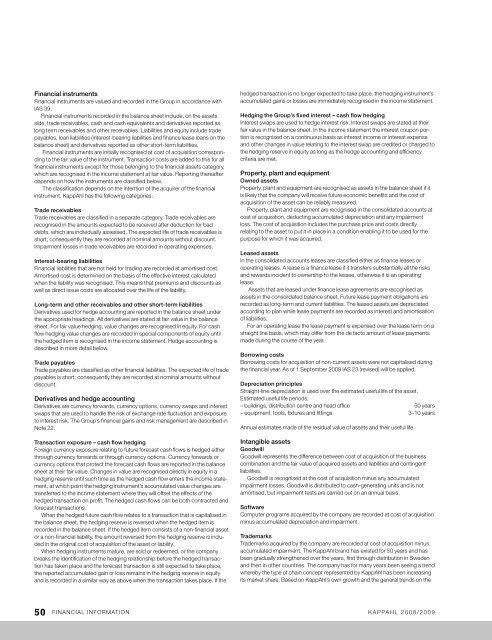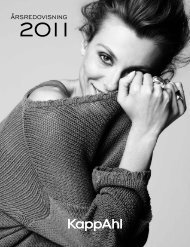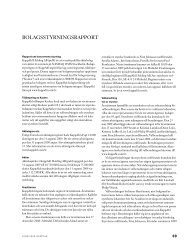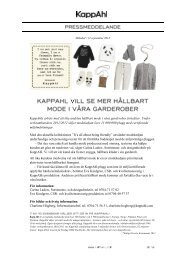We - KappAhl
We - KappAhl
We - KappAhl
Create successful ePaper yourself
Turn your PDF publications into a flip-book with our unique Google optimized e-Paper software.
Financial instruments<br />
financial instruments are valued and recorded in the Group in accordance with<br />
iaS 39.<br />
financial instruments recorded in the balance sheet include, on the assets<br />
side, trade receivables, cash and cash equivalents and derivatives reported as<br />
long term receivables and other receivables. liabilities and equity include trade<br />
payables, loan liabilities (interest-bearing liabilities and finance lease loans on the<br />
balance sheet) and derivatives reported as other short-term liabilities.<br />
financial instruments are initially recognised at cost of acquisition corresponding<br />
to the fair value of the instrument. transaction costs are added to this for all<br />
financial instruments except for those belonging to the financial assets category,<br />
which are recognised in the income statement at fair value. reporting thereafter<br />
depends on how the instruments are classified below.<br />
the classification depends on the intention of the acquirer of the financial<br />
instrument. Kappahl has the following categories:<br />
Trade receivables<br />
trade receivables are classified in a separate category. trade receivables are<br />
recognised in the amounts expected to be received after deduction for bad<br />
debts, which are individually assessed. the expected life of trade receivables is<br />
short; consequently they are recorded at nominal amounts without discount.<br />
impairment losses in trade receivables are recorded in operating expenses.<br />
Interest-bearing liabilities<br />
financial liabilities that are not held for trading are recorded at amortised cost.<br />
amortised cost is determined on the basis of the effective interest calculated<br />
when the liability was recognised. this means that premiums and discounts as<br />
well as direct issue costs are allocated over the life of the liability.<br />
Long-term and other receivables and other short-term liabilities<br />
Derivatives used for hedge accounting are reported in the balance sheet under<br />
the appropriate headings. all derivatives are stated at fair value in the balance<br />
sheet. for fair value hedging, value changes are recognised in equity. for cash<br />
flow hedging value changes are recorded in special components of equity until<br />
the hedged item is recognised in the income statement. hedge accounting is<br />
described in more detail below.<br />
Trade payables<br />
trade payables are classified as other financial liabilities. the expected life of trade<br />
payables is short; consequently they are recorded at nominal amounts without<br />
discount.<br />
Derivatives and hedge accounting<br />
Derivatives are currency forwards, currency options, currency swaps and interest<br />
swaps that are used to handle the risk of exchange rate fluctuation and exposure<br />
to interest risk. the Group’s financial gains and risk management are described in<br />
note 22.<br />
Transaction exposure – cash flow hedging<br />
foreign currency exposure relating to future forecast cash flows is hedged either<br />
through currency forwards or through currency options. currency forwards or<br />
currency options that protect the forecast cash flows are reported in the balance<br />
sheet at their fair value. changes in value are recognised directly in equity in a<br />
hedging reserve until such time as the hedged cash flow enters the income statement,<br />
at which point the hedging instrument’s accumulated value changes are<br />
transferred to the income statement where they will offset the effects of the<br />
hedged transaction on profit. the hedged cash flows can be both contracted and<br />
forecast transactions.<br />
When the hedged future cash flow relates to a transaction that is capitalised in<br />
the balance sheet, the hedging reserve is reversed when the hedged item is<br />
recorded in the balance sheet. if the hedged item consists of a non-financial asset<br />
or a non-financial liability, the amount reversed from the hedging reserve is included<br />
in the original cost of acquisition of the asset or liability.<br />
When hedging instruments mature, are sold or redeemed, or the company<br />
breaks the identification of the hedging relationship before the hedged transaction<br />
has taken place and the forecast transaction is still expected to take place,<br />
the reported accumulated gain or loss remains in the hedging reserve in equity<br />
and is recorded in a similar way as above when the transaction takes place. if the<br />
hedged transaction is no longer expected to take place, the hedging instrument’s<br />
accumulated gains or losses are immediately recognised in the income statement.<br />
Hedging the Group’s fixed interest – cash flow hedging<br />
interest swaps are used to hedge interest risk. interest swaps are stated at their<br />
fair value in the balance sheet. in the income statement the interest coupon portion<br />
is recognised on a continuous basis as interest income or interest expense<br />
and other changes in value relating to the interest swap are credited or charged to<br />
the hedging reserve in equity as long as the hedge accounting and efficiency<br />
criteria are met.<br />
Property, plant and equipment<br />
Owned assets<br />
property, plant and equipment are recognised as assets in the balance sheet if it<br />
is likely that the company will receive future economic benefits and the cost of<br />
acquisition of the asset can be reliably measured.<br />
property, plant and equipment are recognised in the consolidated accounts at<br />
cost of acquisition, deducting accumulated depreciation and any impairment<br />
loss. the cost of acquisition includes the purchase price and costs directly<br />
relating to the asset to put it in place in a condition enabling it to be used for the<br />
purpose for which it was acquired.<br />
Leased assets<br />
in the consolidated accounts leases are classified either as finance leases or<br />
operating leases. a lease is a finance lease if it transfers substantially all the risks<br />
and rewards incident to ownership to the lessee, otherwise it is an operating<br />
lease.<br />
assets that are leased under finance lease agreements are recognised as<br />
assets in the consolidated balance sheet. future lease payment obligations are<br />
recorded as long-term and current liabilities. the leased assets are depreciated<br />
according to plan while lease payments are recorded as interest and amortisation<br />
of liabilities.<br />
for an operating lease the lease payment is expensed over the lease term on a<br />
straight line basis, which may differ from the de facto amount of lease payments<br />
made during the course of the year.<br />
Borrowing costs<br />
Borrowing costs for acquisition of non-current assets were not capitalised during<br />
the financial year. as of 1 September 2009 iaS 23 (revised) will be applied.<br />
Depreciation principles<br />
Straight-line depreciation is used over the estimated useful life of the asset.<br />
Estimated useful life periods;<br />
– buildings, distribution centre and head office 50 years<br />
– equipment, tools, fixtures and fittings 3–10 years<br />
annual estimates made of the residual value of assets and their useful life.<br />
Intangible assets<br />
Goodwill<br />
Goodwill represents the difference between cost of acquisition of the business<br />
combination and the fair value of acquired assets and liabilities and contingent<br />
liabilities.<br />
Goodwill is recognised at the cost of acquisition minus any accumulated<br />
impairment losses. Goodwill is distributed to cash-generating units and is not<br />
amortised, but impairment tests are carried out on an annual basis.<br />
Software<br />
computer programs acquired by the company are recorded at cost of acquisition<br />
minus accumulated depreciation and impairment.<br />
Trademarks<br />
trademarks acquired by the company are recorded at cost of acquisition minus<br />
accumulated impairment. the Kappahl brand has existed for 50 years and has<br />
been gradually strengthened over the years, first through distribution in Sweden<br />
and then in other countries. the company has for many years been seeing a trend<br />
whereby the type of chain concept represented by Kappahl has been increasing<br />
its market share. Based on Kappahl’s own growth and the general trends on the<br />
50 financial information Kappahl 2008/2009





